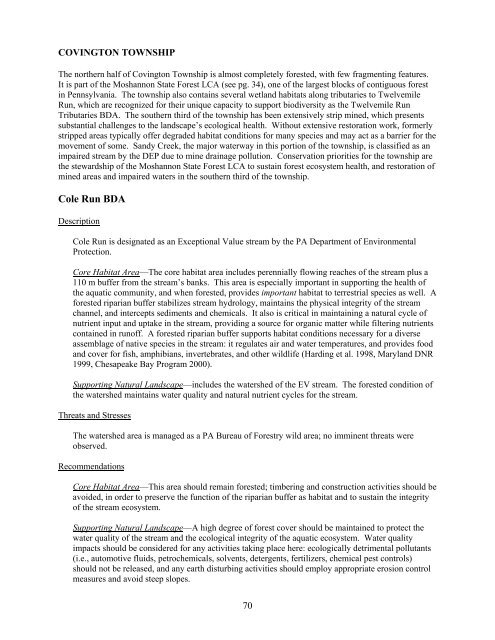introduction - Pennsylvania Natural Heritage Program
introduction - Pennsylvania Natural Heritage Program
introduction - Pennsylvania Natural Heritage Program
You also want an ePaper? Increase the reach of your titles
YUMPU automatically turns print PDFs into web optimized ePapers that Google loves.
COVINGTON TOWNSHIPThe northern half of Covington Township is almost completely forested, with few fragmenting features.It is part of the Moshannon State Forest LCA (see pg. 34), one of the largest blocks of contiguous forestin <strong>Pennsylvania</strong>. The township also contains several wetland habitats along tributaries to TwelvemileRun, which are recognized for their unique capacity to support biodiversity as the Twelvemile RunTributaries BDA. The southern third of the township has been extensively strip mined, which presentssubstantial challenges to the landscape’s ecological health. Without extensive restoration work, formerlystripped areas typically offer degraded habitat conditions for many species and may act as a barrier for themovement of some. Sandy Creek, the major waterway in this portion of the township, is classified as animpaired stream by the DEP due to mine drainage pollution. Conservation priorities for the township arethe stewardship of the Moshannon State Forest LCA to sustain forest ecosystem health, and restoration ofmined areas and impaired waters in the southern third of the township.Cole Run BDADescriptionCole Run is designated as an Exceptional Value stream by the PA Department of EnvironmentalProtection.Core Habitat Area—The core habitat area includes perennially flowing reaches of the stream plus a110 m buffer from the stream’s banks. This area is especially important in supporting the health ofthe aquatic community, and when forested, provides important habitat to terrestrial species as well. Aforested riparian buffer stabilizes stream hydrology, maintains the physical integrity of the streamchannel, and intercepts sediments and chemicals. It also is critical in maintaining a natural cycle ofnutrient input and uptake in the stream, providing a source for organic matter while filtering nutrientscontained in runoff. A forested riparian buffer supports habitat conditions necessary for a diverseassemblage of native species in the stream: it regulates air and water temperatures, and provides foodand cover for fish, amphibians, invertebrates, and other wildlife (Harding et al. 1998, Maryland DNR1999, Chesapeake Bay <strong>Program</strong> 2000).Supporting <strong>Natural</strong> Landscape—includes the watershed of the EV stream. The forested condition ofthe watershed maintains water quality and natural nutrient cycles for the stream.Threats and StressesThe watershed area is managed as a PA Bureau of Forestry wild area; no imminent threats wereobserved.RecommendationsCore Habitat Area—This area should remain forested; timbering and construction activities should beavoided, in order to preserve the function of the riparian buffer as habitat and to sustain the integrityof the stream ecosystem.Supporting <strong>Natural</strong> Landscape—A high degree of forest cover should be maintained to protect thewater quality of the stream and the ecological integrity of the aquatic ecosystem. Water qualityimpacts should be considered for any activities taking place here: ecologically detrimental pollutants(i.e., automotive fluids, petrochemicals, solvents, detergents, fertilizers, chemical pest controls)should not be released, and any earth disturbing activities should employ appropriate erosion controlmeasures and avoid steep slopes.70










